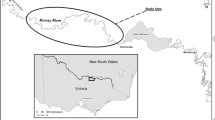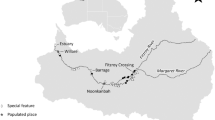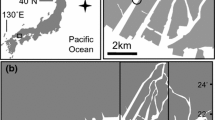Abstract
In fluctuating aquatic environments such as intermittent streams, fish condition is often highly variable due to the associated fluctuating levels of food resources. Having the physiological capacity to both metabolise and catabolise lipids, fish can survive through droughts and rapidly gain condition during flows and floods. Dryland rivers continuously cycle through periods of boom and bust due to their intermittent patterns of rainfall and flow. To help gain an understanding of how fish respond physiologically to varying antecedent flow conditions, we examined body condition measured by percent tissue water content of two generalist fish species in an Australian dryland river. We predicted that fish would be in better condition following recent flows and poorer condition when there had been no recent flows. Our expectations were met for both species with low water tissue content after high flows and high tissue water content after significant drying. It was also found that strong juvenile recruitment was also evident when body condition was high, indicating that when there are food resource spikes driven by flow pulses fish can utilise resources both to produce offspring and to store as lipid for future survival.



Similar content being viewed by others
References
Arthington AH, Balcombe SR, Wilson GG, Thoms MC, Marshall JC (2005) Spatial and temporal variation in fish assemblage structure in isolated waterholes during the 2001 dry season of an arid-zone river, Cooper Creek, Australia. Mar Freshw Res 56:25–35
Balcombe SR, Bunn SE, McKenzie-Smith FJ, Davies PE (2005) Variability of fish diets between dry and flood periods in an arid zone floodplain river. J Fish Biol 67:1552–1567
Burford M, Cook A, Fellows CS, Balcombe SR, Bunn SE (2008) Sources of carbon fuelling production in an arid floodplain river. Mar Freshw Res 59:224–234
Paukert C, Rogers RS (2005) Factors affecting condition of flannelmouth suckers in the Colorado River, Grande Canyon, Arizona. North Am J Fish Manage 24:648–653
Adams SM (1999) Ecological role of lipids in the health and success of fish populations. In: Arts MT et al. (eds) Lipids in freshwater ecosystems. Springer, New York, pp 300–318
Kent M (1990) Hand held instrument for fat/water determination in whole fish. Food Control 1:47–53
Plante S, Lambert Y, De la Noule J (2005) Alternative methods for measuring energy content in winter flounder. North Am J Fish Manage 25:1–6
Balcombe SR, Arthington AH (2009) Temporal changes in fish abundance in response to hydrological variability in a dryland floodplain river. Mar Freshw Res 60:146–159
Puckridge JT, Walker KF, Costelloe JF (2000) Hydrological persistence and the ecology of dryland rivers. Reg Rivers 16:385–402
Balcombe SR, Arthington AH, Foster ND, Thoms MC, Wilson GG, Bunn SE (2006) Fish assemblages of an Australian dryland river: abundance, assemblage structure and recruitment patterns in the Warrego River, Murray–Darling Basin. Mar Freshw Res 57:619–633
Balcombe SR, Bunn SE, Arthington AH, Fawcett JH, McKenzie-Smith FJ, Wright A (2007) Fish larvae, growth and biomass relationships in an Australian arid zone river: links between floodplains and waterholes. Freshw Biol 52:2385–2398
Sternberg D, Balcombe S, Marshall J, Lobegeiger J (2008) Food resource variability in an Australian dryland river: evidence from the diet of two generalist native fish species. Mar Freshw Res 59:137–144
Balcombe SR, Arthington AH, Thoms MC, Wilson GG (2011) Fish assemblage patterns across a gradient of flow regulation in an Australian dryland river system. River Res Appl 27:168–183
Pusey B, Kennard M, Arthington AH (2004) Freshwater fishes of North-eastern Australia. CSIRO, Collingwood
Medeiros ESF, Arthington AH (2008) Diel variation in food intake and diet composition of three native fish species in floodplain lagoons of the Macintyre River, Australia. J Fish Biol 73:1024–1032
Blessing JJ, Marshall JC, Balcombe SR (2010) Humane killing of fish for scientific research: a comparison of two methods. J Fish Biol 76:2571–2577
Lloret J, Galzin R, Gil de Sola L, Souplet A, Demestre M (2005) Habitat related differences in lipid reserves of some exploited fish species in the north western Mediterranean continental shelf. J Fish Biol 67:51–65
Systat Software, Inc. (SSI), (2004). ‘Systat® for Windows®.’ Systat Software, Inc., Richmond
Quinn GP, Keogh MJ (2002) Experimental design and data analysis for biologists. Cambridge University Press, Cambridge
Spranza JJ, Stanley EH (2000) Condition, growth, and reproductive styles of fishes exposed to different environmental regimes in a prairie drainage. Environ Biol Fish 59:99–109
Oliva-Paterna FJ, Minano PA, Torralva M (2003) Habitat quality affects the condition of Barbus sclateri in Mediterranean semi arid streams. Environ Biol Fish 67:13–22
Fellows CS, Bunn SE, Sheldon F, Beard NJ (2009) Benthic metabolism in two turbid floodplain rivers. Freshw Biol 54:236–253
Lloret J, Rätz H (2000) Condition of cod (Gadus morhua) off Greenland during 1982–1988. Fish Res 4:79–86
Richoux NB, Deibel D, Thompson RJ, Parrish CC (2004) Seasonal changes in the lipids of Mysis mixsta (Mysidae) from the hypobenthos of a cold ocean environment (Conception Bay, Newfoundland). Can J Fish Aquat Sci 61:1940–1953
Acknowledgments
The authors would like to thank Louisa Davis, Tariq Kahn, Annette Ritchie, Joanna Blessing and David Sternberg for assistance in collecting field data, and the landholders for their property access and support. Our research was conducted under Queensland fisheries permit PRM00157K and Griffith University Animal Experimentation Ethics Committee permit ENV/06/07.
Author information
Authors and Affiliations
Corresponding author
Rights and permissions
About this article
Cite this article
Balcombe, S.R., Lobegeiger, J.S., Marshall, S.M. et al. Fish body condition and recruitment success reflect antecedent flows in an Australian dryland river. Fish Sci 78, 841–847 (2012). https://doi.org/10.1007/s12562-012-0519-z
Received:
Accepted:
Published:
Issue Date:
DOI: https://doi.org/10.1007/s12562-012-0519-z




